2002 BMW 325XI spare tire
[x] Cancel search: spare tirePage 24 of 155
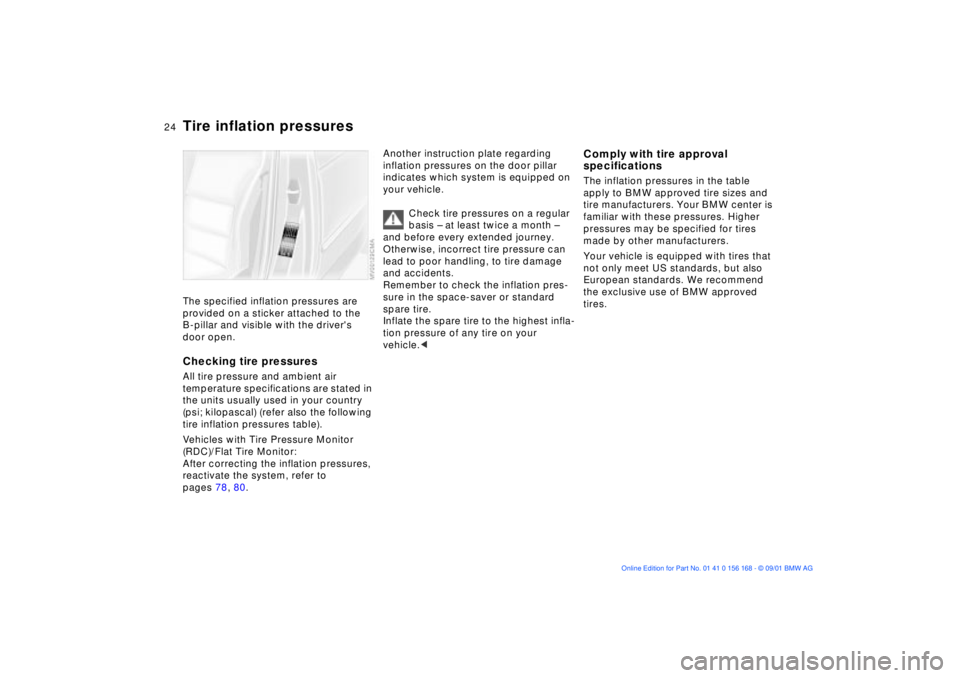
24n
Tire inflation pressures The specified inflation pressures are
provided on a sticker attached to the
B-pillar and visible with the driver's
door open.Checking tire pressuresAll tire pressure and ambient air
temperature specifications are stated in
the units usually used in your country
(psi; kilopascal) (refer also the following
tire inflation pressures table).
Vehicles with Tire Pressure Monitor
(RDC)/Flat Tire Monitor:
After correcting the inflation pressures,
reactivate the system, refer to
pages 78, 80.
Another instruction plate regarding
inflation pressures on the door pillar
indicates which system is equipped on
your vehicle.
Check tire pressures on a regular
basis Ð at least twice a month Ð
and before every extended journey.
Otherwise, incorrect tire pressure can
lead to poor handling, to tire damage
and accidents.
Remember to check the inflation pres-
sure in the space-saver or standard
spare tire.
Inflate the spare tire to the highest infla-
tion pressure of any tire on your
vehicle.<
Comply with tire approval
specificationsThe inflation pressures in the table
apply to BMW approved tire sizes and
tire manufacturers. Your BMW center is
familiar with these pressures. Higher
pressures may be specified for tires
made by other manufacturers.
Your vehicle is equipped with tires that
not only meet US standards, but also
European standards. We recommend
the exclusive use of BMW approved
tires.
Page 25 of 155
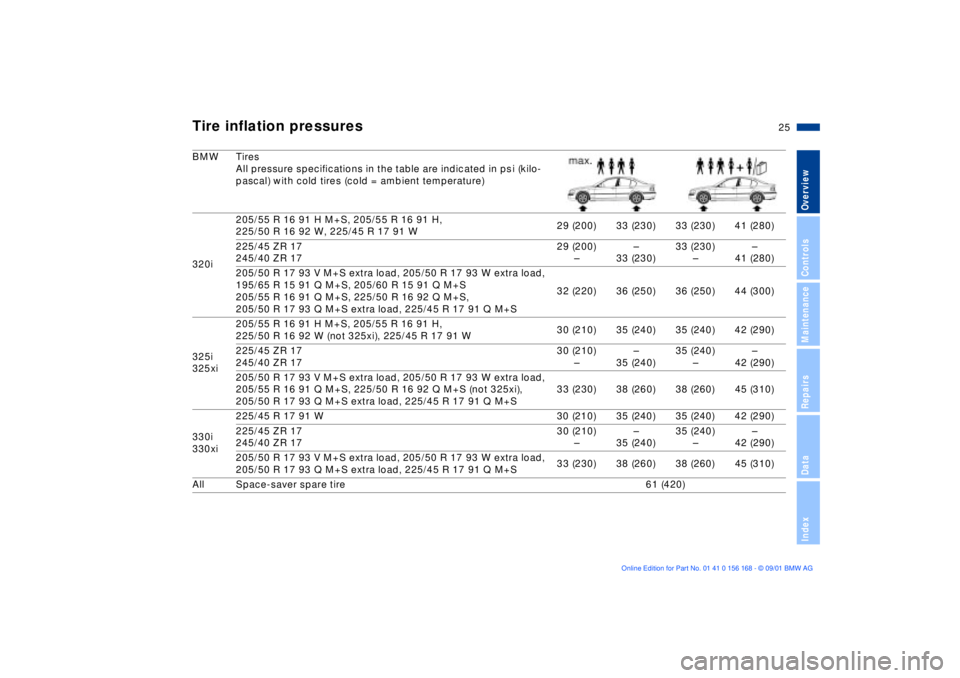
25n
OverviewControlsMaintenanceRepairsDataIndex
Tire inflation pressuresBMW Tires
All pressure specifications in the table are indicated in ps i (kilo-
pascal) with cold tires (cold = ambient temperature)
320i205/55 R 16 91 H M+S, 205/55 R 16 91 H,
225/50 R 16 92 W, 225/45 R 17 91 W29 (200) 33 (230) 33 (230) 41 (280)
225/45 ZR 17
245/40 ZR 1729 (200)
ÐÐ
33 (230)33 (230)
ÐÐ
41 (280)
205/50 R 17 93 V M+S extra load, 205/50 R 17 93 W extra load,
195/65 R 15 91 Q M+S, 205/60 R 15 91 Q M+S
205/55 R 16 91 Q M+S, 225/50 R 16 92 Q M+S,
205/50 R 17 93 Q M+S extra load, 225/45 R 17 91 Q M+S32 (220) 36 (250) 36 (250) 44 (300)
325i
325xi205/55 R 16 91 H M+S, 205/55 R 16 91 H,
225/50 R 16 92 W (not 325xi), 225/45 R 17 91 W30 (210) 35 (240) 35 (240) 42 (290)
225/45 ZR 17
245/40 ZR 1730 (210)
ÐÐ
35 (240)35 (240)
ÐÐ
42 (290)
205/50 R 17 93 V M+S extra load, 205/50 R 17 93 W extra load,
205/55 R 16 91 Q M+S, 225/50 R 16 92 Q M+S (not 325xi),
205/50 R 17 93 Q M+S extra load, 225/45 R 17 91 Q M+S33 (230) 38 (260) 38 (260) 45 (310)
330i
330xi225/45 R 17 91 W 30 (210) 35 (240) 35 (240) 42 (290)
225/45 ZR 17
245/40 ZR 1730 (210)
ÐÐ
35 (240)35 (240)
ÐÐ
42 (290)
205/50 R 17 93 V M+S extra load, 205/50 R 17 93 W extra load,
205/50 R 17 93 Q M+S extra load, 225/45 R 17 91 Q M+S33 (230) 38 (260) 38 (260) 45 (310)
All Space-saver spare tire 61 (420)
Page 79 of 155
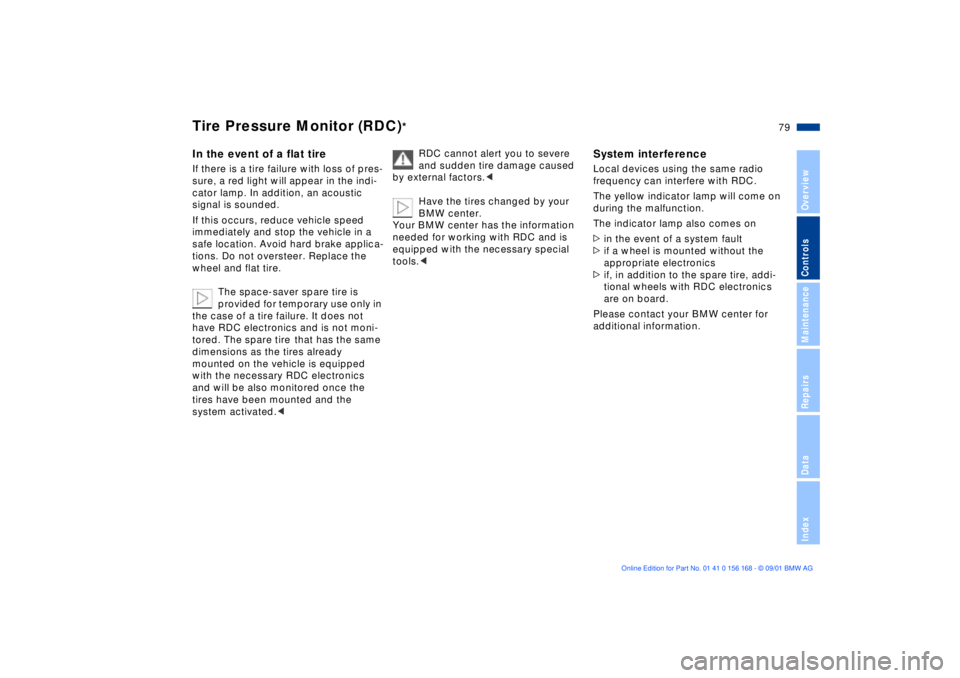
79n
OverviewControlsMaintenanceRepairsDataIndex
Tire Pressure Monitor (RDC)
*
In the event of a flat tireIf there is a tire failure with loss of pres-
sure, a red light will appear in the indi-
cator lamp. In addition, an acoustic
signal is sounded.
If this occurs, reduce vehicle speed
immediately and stop the vehicle in a
safe location. Avoid hard brake applica-
tions. Do not oversteer. Replace the
wheel and flat tire.
The space-saver spare tire is
provided for temporary use only in
the case of a tire failure. It does not
have RDC electronics and is not moni-
tored. The spare tire
that has the same
dimensions as the tires already
mounted on the vehicle is equipped
with the necessary RDC electronics
and will be also monitored once the
tires have been mounted and the
system activated.<
RDC cannot alert you to severe
and sudden tire damage caused
by external factors.<
Have the tires changed by your
BMW center.
Your BMW center has the information
needed for working with RDC and is
equipped with the necessary special
tools.<
System interferenceLocal devices using the same radio
frequency can interfere with RDC.
The yellow indicator lamp will come on
during the malfunction.
The indicator lamp also comes on
>in the event of a system fault
>if a wheel is mounted without the
appropriate electronics
>if, in addition to the spare tire, addi-
tional wheels with RDC electronics
are on board.
Please contact your BMW center for
additional information.
Page 107 of 155
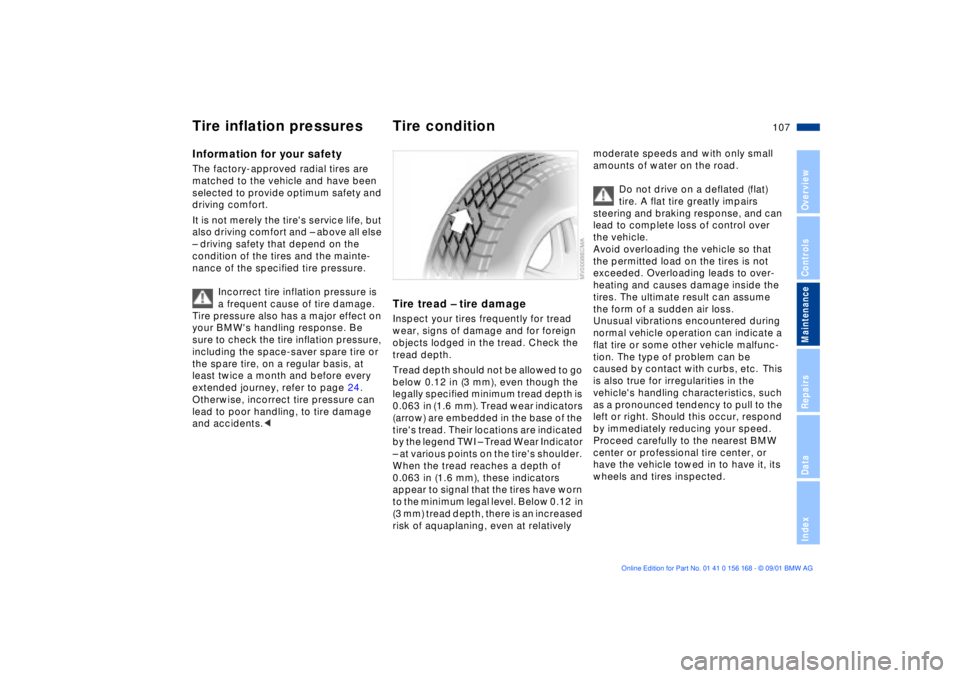
107n
OverviewControlsMaintenanceRepairsDataIndex
Information for your safetyThe factory-approved radial tires are
matched to the vehicle and have been
selected to provide optimum safety and
driving comfort.
It is not merely the tire's service life, but
also driving comfort and Ð above all else
Ð driving safety that depend on the
condition of the tires and the mainte-
nance of the specified tire pressure.
Incorrect tire inflation pressure is
a frequent cause of tire damage.
Tire pressure also has a major effect on
your BMW's handling response. Be
sure to check the tire inflation pressure,
including the space-saver spare tire or
the spare tire, on a regular basis, at
least twice a month and before every
extended journey, refer to page 24.
Otherwise, incorrect tire pressure can
lead to poor handling, to tire damage
and accidents.<
Tire tread Ð tire damageInspect your tires frequently for tread
wear, signs of damage and for foreign
objects lodged in the tread. Check the
tread depth.
Tread depth should not be allowed to go
below 0.12 in (3 mm), even though the
legally specified minimum tread depth is
0.063 in (1.6 mm). Tread wear indicators
(arrow) are embedded in the base of the
tire's tread. Their locations are indicated
by the legend TWI Ð Tread Wear Indicator
Ð at various points on the tire's shoulder.
When the tread reaches a depth of
0.063 in (1.6 mm), these indicators
appear to signal that the tires have worn
to the minimum legal level. Below 0.12 in
(3 mm) tread depth, there is an increased
risk of aquaplaning, even at relatively
moderate speeds and with only small
amounts of water on the road.
Do not drive on a deflated (flat)
tire. A flat tire greatly impairs
steering and braking response, and can
lead to complete loss of control over
the vehicle.
Avoid overloading the vehicle so that
the permitted load on the tires is not
exceeded. Overloading leads to over-
heating and causes damage inside the
tires. The ultimate result can assume
the form of a sudden air loss.
Unusual vibrations encountered during
normal vehicle operation can indicate a
flat tire or some other vehicle malfunc-
tion. The type of problem can be
caused by contact with curbs, etc. This
is also true for irregularities in the
vehicle's handling characteristics, such
as a pronounced tendency to pull to the
left or right. Should this occur, respond
by immediately reducing your speed.
Proceed carefully to the nearest BMW
center or professional tire center, or
have the vehicle towed in to have it, its
wheels and tires inspected.
Tire inflation pressures
Tire condition
Page 129 of 155

129n
OverviewControlsMaintenanceRepairsDataIndex
Changing a wheel
Safety precautions in the event of
a flat tire or wheel change:
Stop the vehicle as far as possible from
passing traffic. Park on a firm, flat,
surface. Switch on the hazard warning
flashers. Turn the steering wheel to the
straight-ahead position and engage the
steering lock. Shift into 1st or reverse
(selector lever in Park with automatic
transmission) and engage the parking
brake.
All passengers should be outside the
vehicle and well away from your imme-
diate working area (behind a guardrail,
for example).
If a warning triangle or portable hazard
warning lamp is available, set it up on
the roadside at an appropriate distance
from the rear of the vehicle. Comply
with all safety guidelines and regula-
tions.
Change the wheel only on a level, firm
surface which is not slippery. Avoid
jacking the vehicle on a soft or slippery
support surface (snow, ice, loose
gravel, etc.), as either the vehicle or the
jack could slip sideways.
Position the jack on a firm support
surface.
Do not place wooden blocks or similar
objects under the jack. They could
prevent the jack from extending to its
full height and reduce its support
capacity.
Do not lie under the vehicle or start the
engine when the vehicle is supported
by the jack Ð risk of fatal injury.<
Your BMW is equipped with a spare tire
or a space-saver spare tire designed for
temporary use in maintaining the
vehicle's mobility in an emergency.
To remove the spare tire, lift the
floor panel in the luggage
compartment completely out, refer to
page 35.<
What you will needIn order to avoid rattling noises later,
note the position of the tools when you
remove them and return them to their
original position when you are done
using them.
>Jack 1
Lift the floor panel within the luggage
compartment, refer to page 35 and
undo the red wingnut (arrow).
When you have completed work,
screw the jack all the way back
down. Fold the handle back and
insert it in its holder
>Chock 2
Located behind the jack on the wall
in the luggage compartment. Loosen
the wing nut to remove it
Page 130 of 155
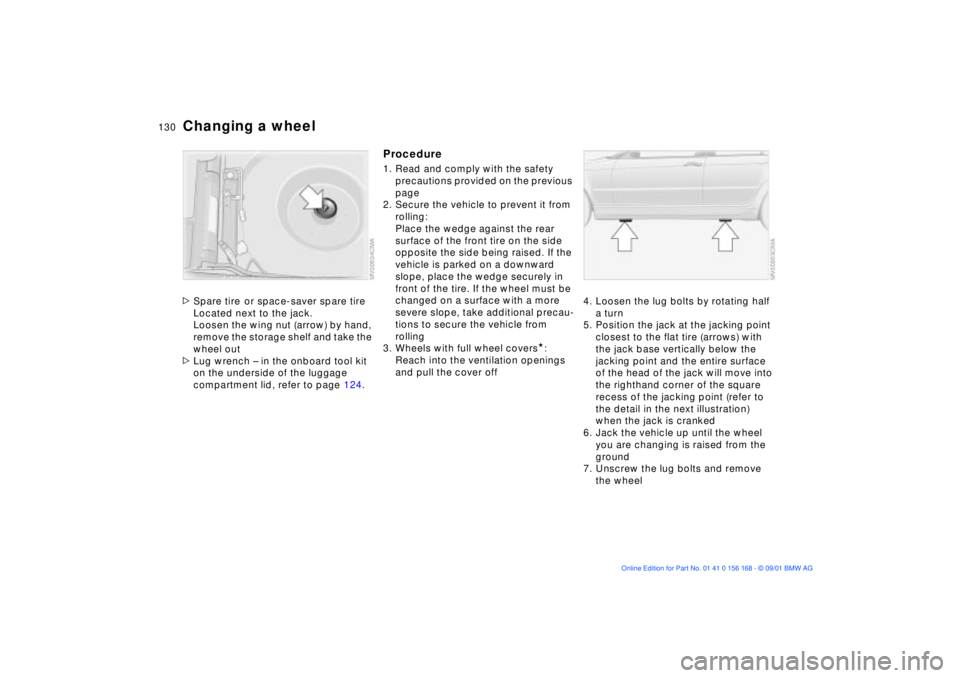
130n
Changing a wheel>Spare tire
or space-saver spare tire
Located next to the jack.
Loosen the wing nut (arrow) by hand,
remove the storage shelf and take the
wheel out
>Lug wrench Ð in the onboard tool kit
on the underside of the luggage
compartment lid, refer to page 124.
Procedure1. Read and comply with the safety
precautions provided on the previous
page
2. Secure the vehicle to prevent it from
rolling:
Place the wedge against the rear
surface of the front tire on the side
opposite the side being raised. If the
vehicle is parked on a downward
slope, place the wedge securely in
front of the tire. If the wheel must be
changed on a surface with a more
severe slope, take additional precau-
tions to secure the vehicle from
rolling
3. Wheels with full wheel covers
*:
Reach into the ventilation openings
and pull the cover off4. Loosen the lug bolts by rotating half
a turn
5. Position the jack at the jacking point
closest to the flat tire (arrows) with
the jack base vertically below the
jacking point and the entire surface
of the head of the jack will move into
the righthand corner of the square
recess of the jacking point (refer to
the detail in the next illustration)
when the jack is cranked
6. Jack the vehicle up until the wheel
you are changing is raised from the
ground
7. Unscrew the lug bolts and remove
the wheel
Page 131 of 155

131n
OverviewControlsMaintenanceRepairsDataIndex
Changing a wheel8. Remove accumulations of mud or
dirt from the mounting surfaces of
the wheel and hub. Clean the lug
bolts
9. Position the new wheel or the
space saver spare tire on the hub
and screw at least two lug bolts
finger-tight into opposite bolt holes
10. Screw in the remaining lug bolts
and screw in all the bolts in a diag-
onal pattern
11. Lower the jack and remove it from
beneath the vehicle
12. Tighten the lug bolts securely in a
diagonal pattern
13. Wheels with full wheel covers
*:
Place the wheel cover with the
valve opening (arrow) over the
valve. Use both hands to press the
cover securely onto the rim
14. Check and correct the tire inflation
pressure at the earliest opportunity.
Vehicles with Tire Pressure Monitor
(RDC)/Flat Tire Monitor:
After mounting the spare tire or
correcting the tire inflation pres-
sure, reactivate the system, refer to
pages 78, 81.
Protect valve stems and valves from dirt
using screw-on valve stem caps. Dirty
valve stems frequently lead to slow
pressure loss.
Only use original BMW full wheel
covers, otherwise, the trim piece
may not fit securely. The full wheel
cover may not be installed on the
space-saver spare tire, since this could
damage the cover.<
The vehicle jack is designed for
changing wheels only. Do not
attempt to raise another vehicle model
with it or to raise any load of any kind.
To do so could cause accidents and
personal injury.
To ensure continued safety, have the
tightness of the torque bolts checked
with a calibrated lug wrench [torque
specification: 72 lb ft (100 Nm)] at the
earliest opportunity.<
When storing a wheel in the spare tire
recess take care to avoid bending the
threaded rod.
If light-alloy wheels other than original
BMW light-alloy wheels have been
mounted, it may be necessary to use
different lug bolts for those wheels.
Replace the defective tire as soon as
possible and have the new wheel/tire
balanced.
Page 132 of 155
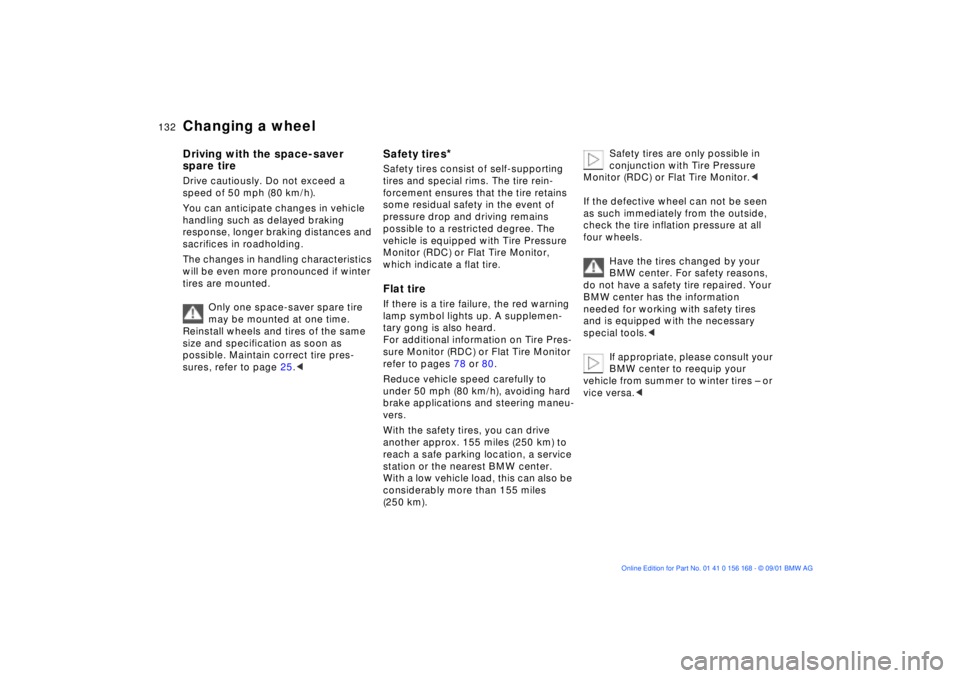
132n
Changing a wheelDriving with the space-saver
spare tireDrive cautiously. Do not exceed a
speed of 50 mph (80 km/h).
You can anticipate changes in vehicle
handling such as delayed braking
response, longer braking distances and
sacrifices in roadholding.
The changes in handling characteristics
will be even more pronounced if winter
tires are mounted.
Only one space-saver spare tire
may be mounted at one time.
Reinstall wheels and tires of the same
size and specification as soon as
possible. Maintain correct tire pres-
sures, refer to page 25.<
Safety tires
*
Safety tires consist of self-supporting
tires and special rims. The tire rein-
forcement ensures that the tire retains
some residual safety in the event of
pressure drop and driving remains
possible to a restricted degree. The
vehicle is equipped with Tire Pressure
Monitor (RDC) or Flat Tire Monitor,
which indicate a flat tire.Flat tireIf there is a tire failure, the red warning
lamp symbol lights up. A supplemen-
tary gong is also heard.
For additional information on Tire Pres-
sure Monitor (RDC) or Flat Tire Monitor
refer to pages 78 or 80.
Reduce vehicle speed carefully to
under 50 mph (80 km/h), avoiding hard
brake applications and steering maneu-
vers.
With the safety tires, you can drive
another approx. 155 miles (250 km) to
reach a safe parking location, a service
station or the nearest BMW center.
With a low vehicle load, this can also be
considerably more than 155 miles
(250 km).Safety tires are only possible in
conjunction with Tire Pressure
Monitor (RDC) or Flat Tire Monitor.<
If the defective wheel can not be seen
as such immediately from the outside,
check the tire inflation pressure at all
four wheels.
Have the tires changed by your
BMW center. For safety reasons,
do not have a safety tire repaired. Your
BMW center has the information
needed for working with safety tires
and is equipped with the necessary
special tools.<
If appropriate, please consult your
BMW center to reequip your
vehicle from summer to winter tires Ð or
vice versa.<